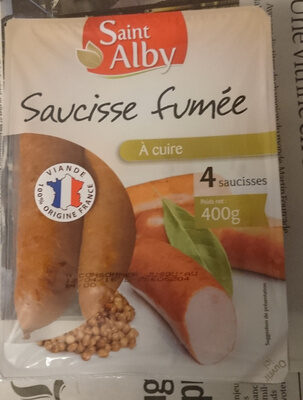Saucisses fumées - Saint Alby - 400 g
Ambiguous barcode: This product has a Restricted Circulation Number barcode for products within a company. This means that different producers and stores can use the same barcode for different products.
×
This product page is not complete. You can help to complete it by editing it and adding more data from the photos we have, or by taking more photos using the app for Android or iPhone/iPad. Thank you!
×
Barcode: 20637217
Quantity: 400 g
Packaging: Tray
Brands: Saint Alby
Categories: Meats and their products, Meats, Prepared meats, Sausages, French sausages, Smoked sausages, fr:Charcuteries à cuire
Labels, certifications, awards:
French meat, French pork, Nutriscore, Nutriscore Grade D, Triman
Origin of ingredients: France
Manufacturing or processing places: France
Traceability code: FR 56.010.001 CE - Baud (Morbihan, France), FR 56.140.006 CE - Moréac (Morbihan, France)
Stores: Lidl
Countries where sold: France
Matching with your preferences
Health
Ingredients
Food processing
Additives
Ingredients analysis
Nutrition
Environment
Packaging
Transportation
Report a problem
Data sources
Product added on by tacite
Last edit of product page on by foodvisor.
Product page also edited by autorotate-bot, date-limite-app, hommedanslalune, inf, kiliweb, laurent1971, mismer, oizodo, openfoodfacts-contributors, packbot, quechoisir, roboto-app, sebleouf, teolemon, yuka.UmY4NUlvVllsTndtaDh3ZTVEL2N3ZDFINk1HUkFIcTFLL293SVE9PQ, yuka.WDdnaEtvNGhsTjRYdnZFUjV6M081L2RyNmFTTFlXMjlLYlFKSVE9PQ, yuka.WjZBRkxvQWF1LzBVbHMwMTR6MzczL3h0K3FDT1dIN3ZKOVE3SVE9PQ, yuka.ZjVJRUNxYzlwYWxibk13dS9najd5dTRvL3JHbGNrWHRGL1lxSVE9PQ, yuka.sY2b0xO6T85zoF3NwEKvlkdHVdnx-TLLPkDvv2S7mv6EFsK3cY0tzLb1H6s.







